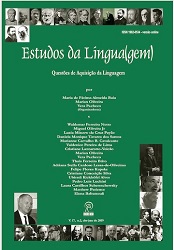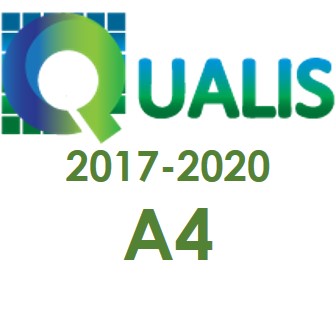Libras articulatory components and SEL writing
DOI:
https://doi.org/10.22481/el.v17i2.5338Keywords:
Articulatory structure; Libras; Sign; writing system.Abstract
This article presents the results of a research project which aimed to create a writing system for sign languages that could be written in handwritten and typed form as well as it could be learnt easily. We concentrated efforts in the investigation of the articulatory nature of the sign of Brazilian Sign Language (Libras) in order to be able to create its system of written representation that could undergo automation of processing. Our investigation led us to identify the articulatory structure of Libras signs which is constituted of four hierarchical levels. Based on this structure, we elaborated the writing system for sign languages, which is as well based on arbitrariness and linearity aspects. As a result, we obtained a system capable of representing Libras in the written mode, in a linear way, encompassing its three-dimensionality with a high degree of precision and attending to the condition of automation of the processing in reading and writing.
Downloads
References
ALMEIDA, Maria Antonieta P. T.; LESSA-DE-OLIVEIRA, Adriana S. C. O sinal e a estrutura argumental da Língua Brasileira de Sinais Veredas On-Line – Atemática – 2014/2 - P. 267-289.
BARROS, Mariângela Estelita. ELiS – Escrita das línguas de sinais: proposta teórica e verificação prática. 197f. Tese (Doutorado em Linguística). Universidade Federal de Santa Catarina. Florianópolis, 2008.
BATTISON, R. Phonological deletion in American Sign Language. Sign Language Studies, v. 5, p.1-19, 1974. BATTISON, R. Lexical borrowing in American sign language. Silver Spring, MD: Linstok, 1978.
DUNCAN, S. Gesture in language: Issues for sign language research. In.: EMMOREY, K. (Ed.). Perspectives on classifier constructions in sign language. Mahwah, NJ: Lawrence Earlbaum Associates. 2003. p.259-268.
KATO, M. A. No mundo da escrita: uma perspectiva psicolingüística. 5ª ed. São Paulo: Ática. 1995.
KENDON, A. Gesture: Visible action as utterance. 1.ed. Cambridge: Cambridge University Press. 2004. 400p.
KLIMA, E.; BELLUGI, U. The signs of language. Cambridge, Mass.: Harvard University Press. 1979. 417p.
LESSA-DE-OLIVEIRA, Adriana S. C. Libras escrita: o desafio de representar uma língua tridimensional por um sistema de escrita linear. ReVEL, v. 10, n. 19, 2012.
[www.revel.inf.br].
_____. Estrita SEL – Sistema de Escrita para Língua de Sinais. [Blog Internet]. Vitória da Conquista, Brasil. Disponível em: <http://sel-libras.blogspot.com.br/>.
LIDDELL, S. K. Grammar, gesture, and meaning in American Sign Language. 1.ed. Cambridge: Cambridge University Press. 2003a. 384p.
LIRA, G. A; FELIPE, T. Dicionário da língua brasileira de sinais. 2008. Disponível em: http://www.acessobrasil.org.br/libras/
LYONS, John. Language and Linguistics. University of Cambridge. Paperback. Publication date: June 1981. 370pages.
McCLEARY, L.; VIOTTI, E. Veredas On Line – Atemática –– PPG Linguística/Ufjf – Juiz de Fora. p. 289-304., 1/2011,
McNEILL, D. Hand and mind: What gestures reveal about thought. 1.ed. Chicago/Londres: The University of Chicago Press. 1992. 416p.
SAUSSURE, Ferdinand de. Curso de Linguística Geral. Tradução de Antônio Chelini, José Paulo Paes e Izidoro Blikstein. 28. ed. São Paulo: Cultrix, 2006.
SOUZA, W. S. M. O discurso de crianças surdas: entre os sons e os sinais. Disponível em:www.cesjf.br/cesjf/documentos/revista_letras_docs/art_alunos/LINGUA_PORT_LING/O_discurso_das_criancas_surdas.pdf. Acesso em: abril de 2009.
STOKOE, W. C. Sing language structure: An Outline of the Visual Communication System of the American Deaf. New York: Buffalo University, 1960.
STUMPF, M. R. O papel da marcação não-manual nas sentenças negativas em língua de sinais brasileira. 2005. 329 p. Tese (Doutorado em Pós-Graduação em Informática na Educação) - Universidade Federal do Rio Grande do Sul. Porto Alegre.
SUTTON, V. Sign writting. 1974. Disponível em: http://www.signwriting.org. Acesso em: abril de 2009.
Downloads
Published
How to Cite
Issue
Section
License
Copyright (c) 2019 Language Studies

This work is licensed under a Creative Commons Attribution 4.0 International License.

Estudos da Língua(gem) is licensed under a Creative Commons Attribution 4.0 International License.
Authors who publish in the journal Estudos da Língua (gem) agree with the following terms:
The journal Estudos de Língua(gem) maintains the copyrights of the contributions published. These rights include the publication of the contribution and make its content available for free through the portal.







